making a videogame about time, apples and sometimes love which you can play at goneloot.itch.io/the-apple-of-our-time
Don't wanna be here? Send us removal request.
Text
bugs :)
glimpse into my beautiful imaginary world where arthropods are really big and we domesticated them




83K notes
·
View notes
Text
How to program a Badge/Medal/Memento system
One of the more interesting and important systems in the Paper Mario series is the badge system. I really like it. But it can do so much, how do you program it?
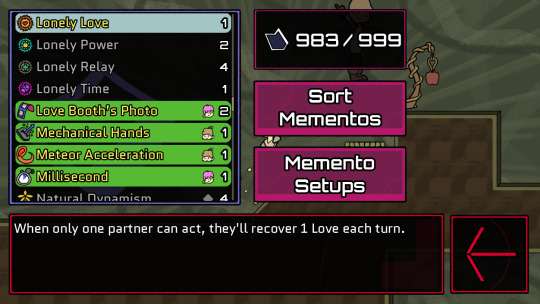
This one will be a bit more technical than the others, but I want to write this in hope it helps anyone. I won’t go all out on programming jargon, but I hope to be clear enough to follow on your own if you’re interested on making a system like mine.
Let’s think: what does the Badge system allow? You first equip one through a menu, and it does pretty much anything in battle. The first part isn’t much more complicated than a menu you choose from, there are plenty tutorials on how to do that. You can make it so that you can choose who you give every badge to like in Bug Fables, you can make it so that each badge only affects someone like in Paper Mario, etc. The specifics are not very important for this exercise, so just make that menu how you want to for your project.
Now, how do you allow anything to happen in battle? Some seem easy, like increase attack by one, but what if you want something very complicated? Let’s start with an example from my own project: A medal called Surprise Gift: “When your Love (AKA Magic) stat reaches 0, it recovers back to half”. How would you implement that? Sure, you could hard-code it for every player character: “if has medal, do stuff”, but doing that with every medal would be unsustainable, and this is a really simple thing! Imagine anything more complex!
The solution I came up with is events. Each thing that can happen in a battle (Battle started, turn started, taken damage, got healed, etc.) has an associated event . When thing X happens, it calls a function on what I call the “Event Manager” to signal that “event X has taken place”. Going back to Surprise Gift it’s easy to figure out what event should trigger it: the “Love stat has changed” event. With this event, variables are also shared: in this example, the “current_Love” stat is passed to the Event Manager, so when that event is triggered it can call a function that takes the current_Love as input, and does the check for “If player.current_Love == 0 then player.current_Love = player.Max_Love /2″. Simple!

That’s... really it! Each medal has a list of events where it should trigger, a list of methods (or functions, however you want to call them) that correspond to those events. So, at the beginning of battle those events and functions are ordered into lists for each event by the Event Manager, so when an event is triggered, the event manager calls one by one the methods that correspond to that event. Benefits of this implementation instead of hard-coding everything? It’s simpler to edit values and make different badges without messing with code, it allows for easy implementation of complicated medals, allowed me to make every medal in the game stackable, etc. Plus, this system allowed me to make a Badge that generates a random medal every battle by stitching together events, so that’s gotta account for something.
Of course, it is a bit more complicated than that. For example, it’d be wise to implement a badge priority system so that, for example, a medal that “lowers the price of abilities” is always triggered after all badges that give you an ability. But I leave solving those as an exercise to the reader. There are definitely better ways to program a system as this, I’m sure, but, if anything, I hope this helps as a starting off point.
If you want to see some of my medal designs and think for yourself “how was this implemented”, you can do so here.
2 notes
·
View notes
Text
UI design and Themes
UI sucks amirite. Since this game is an RPG, menus are one of the most important parts of the game since you’re gonna be seeing those menus a lot.
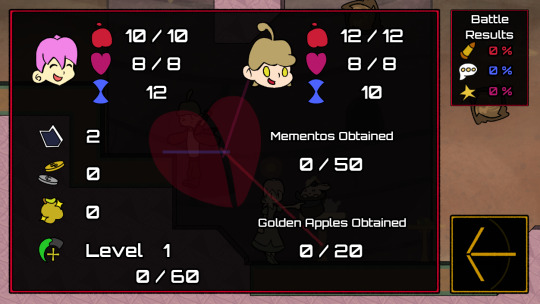
First is the functional side of things. Since in this game you need to aim your attacks, having to choose from a list menu then aim would mess with the flow so much. So, I made it so the transition from menu to aiming was seamless: a radial menu! Which also works thematically since now it’s a circular menu where you aim with your hands, like a clock!
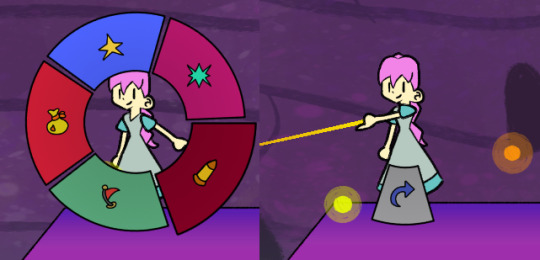
That’s the other part, the visual flare. Since I wanted the menus are so important, I wanted them to not be generic menus. That’s where the themes of the game come into place! If you design your menu as “just a menu” it will look like that, a boring generic menu. If you want to design something that isn’t generic, you must think of a specific idea.
So that’s why almost every menu is love, apples or time themed.
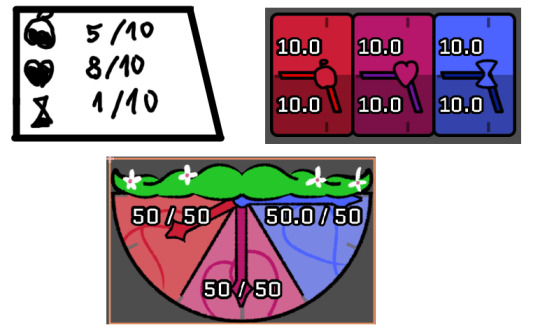
The HP bars? Clocks and some flowers to represent apples. The evolution for the idea, at different stages (The bottom one is the final one).


Same for the foes’ HP bar. Also a clock. The first version was clearer on that theme, but it was ugly sooo.

The Dialogue Box? Clock. I don’t have the old designs for it, but I know I designed a couple before settling into this.

The options menu? Obviously apples. (And also the modifiers button? A polaroid. The back arrow? A Clock too.)
And so on and so forth.
So that’s my advice, I guess. Get a good theme and stick to it.
If you have a shallow theme the design will come out shallow, but if you have a very particular design theme it’ll come out unique. Maybe not good because , but at least unique.
The theme, of course, should relate to what you want your project to be. It doesn’t even have to be anything deep, at all, but you should have something.
Not to be mean, but I genuinely think that if your piece of art has nothing to say, has no themes to convey -even if those themes are as simple as “friendship”, “adventure” or whatever- I think you should reconsider. Thematic depth is not the opposite of fun and, at least to me, makes media much more engaging. Even if those themes are purely visual aesthetic. Even if those menus are just a clock hidden in every piece of UI.
If you want to experience the stupid apple menus, you can do so here.
#indiegame#paperverse#UI#the stats menu has a functional analogue clock#because I didn't know how else to fill the space#so I took that pic at around 9:00 PM
2 notes
·
View notes
Text
Story of Shin Megami Apples
This game has a story. Shocker, I know. I’m not going to spoil anything about it, but I do want to share a bit of how it came to be.
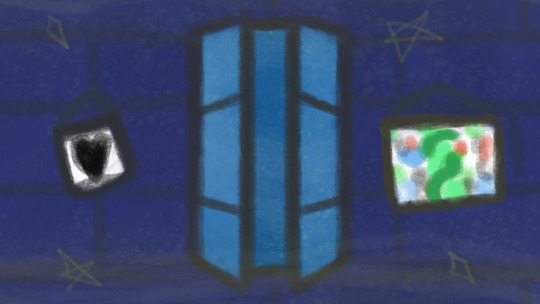
A background used in the second area.
The first pitch for the game was a simple story of “Oh noes! Stephanie’s time machine broke and now she needs to get back home! Travel past and future and... get back I guess”. Just a justification to make the game a basic adventure, and meeting fun characters.
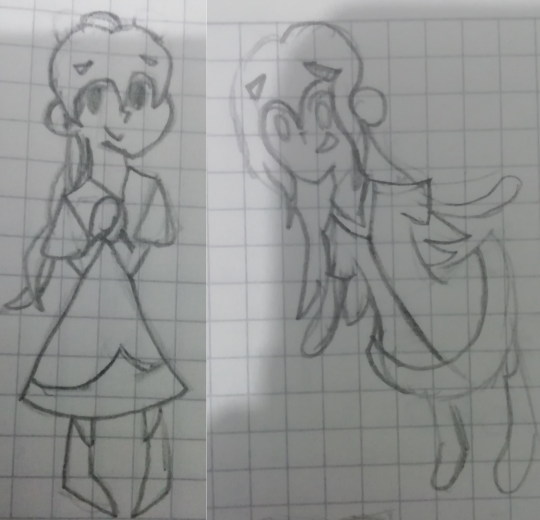
Some of the first Stephanie doodles!
But, for the final boss, I thought it would be really funny to make the final boss a god, because you can’t have an RPG without killing a god at the end. So I searched gods of time and I found the concept of the kairos, the eon and the chronos of Greek philosophy and the idea of the game came to me almost instantly.
With that idea, Thomas, her boyfriend, was added to the story instead of being a Steph solo-adventure. And since his deal was that he could cook pies, I thought to myself “apples”. And that’s why this game is apple, love and time. Like pulled from a hat, I wouldn’t have it any other way.
After that, I just started researching more mythology. And what I learned helped me make the story. For example, the first area was originally going to be just the tutorial area, not much more. But then, I learned of the norse goddess Idun and said “A goddess... of apples?? I have to add her in” so I did, and based the first area on her most important. Plus, that gave me an excuse to add golden apples as collectables and... c’mon, that’s cool. Having stuff to base the characters on makes it so much easier to come up with ideas. Shocker, I know.
As for the areas themselves, they are each based on art pieces! The first one is very clearly based on that very famous melting clock one plus other surrealist pieces from Salvador Dali and Rene Magritte, the second area is based on many expressionist and impressionist paintings, and the last area... well, it’s the one that gave the idea for making everything be based on art pieces. It’s a painting that I saw and inspired this whole ordeal.

An older version of the first area BG, but it was just too distracting for my liking.
Why is it based on art? Aside of it just being cool, the art references do tell a story too! It’s not, like, crucial to the game, and some of the reasons are very surface level, but I do feel it makes the areas stand out more. Plus, it helps me make backgrounds and decorations easier.
If I could add *anything* to the game, whatever I want, how do you even start? By basing it on the themes of the game and/or art pieces, it narrows down the scope of backgrounds and decorations, and helps me get things done. In general, I think themes are the most important thing to figure out from the beginning if you don’t want your own projects to be generic, but maybe I’ll talk about it another time.
It’s also an excuse to learn about nice art, nice cultures and mythology and not-so-nice art history and not-so-nice history .
If you wanna see the game and ask yourself “Why is Mercury a dog” you can do so here.
#Indiegame#paperverse#the depictions of aion in mythology always depict him as naked. I didn't have the courage to make it that way in-game im sorry
2 notes
·
View notes
Text
Challenge? Modifiers? Randomizer?
I love random ways to alter gameplay in silly ways.
This game has challenges? Why? Because if you design the game around their existence, they are not very hard to implement and add a lot of replayability.

Challenges are just a set of modifiers, and most modifiers are really, really simple rule changes. I won’t go over them since you can probably imagine how “Multiply enemy HP by 2″ works in-game.

The only one that might not be evident is “Memento Power”, which simply makes it so that each memento acts as if two copies are equipped. Because yes, every memento stacks with itself. Every single one. This is one of those things that you can only do if you plan it from the beginning, because if you don’t plan around it, going back and adding effects will be a great pain.

(Fun fact! When you have an option on its default value, it changes color! This was taken from TTYD: Infinite Pit because it’s such an useful little detail)
The ones that were tougher to crack where the randomizer, shufflizer, chaos mode and random MP. And these aren’t even that complicated:

Shufflizer: grab the list that contains all items, and shuffle it deterministically (with the given seed). This way, playthroughs can be just a bit different.
Randomizer: grab a random set of items and mementos and put them on a list, then feed it to the shufflizer algorithm. This way you can have some fun.
Chaos Mode: Simply replace all mementos with Tilted Cart (Equips one random memento every battle). You play this if you are insane.
Random MP: Grab the list that contains the MP prices of all mementos, and feed it to the shufflizer algorithm. A friend specifically asked for this one :).
It’s pretty easy to do. The only problem was conceptual: What to do if you have both the shufflizer and randomizer at the same time. I could simply disable it. But where’s the fun in that?
Shufflizer + Randomizer: Hides every item’s icon until you pick it up.
Shufflizer + Chaos Mode: Shuffles every item.
Randomizer + Chaos Mode: Replaces some mementos with Scratched Disk, instead. This one gives three random memento effects at random “events”. Inspired by The Binding of Isaac’s TMTRAINER item.
Shufflizer + Randomizer + Chaos Mode: Same as previous, but also hides items.
Random MP + Fixed Memento Cost: It keeps the fixed cost, but randomizes memento icons.
Again, these weren’t very hard to implement. Like, if you can implement a badge system, you can easily implement a randomizer one. So if you plan on having a system like that, randomizers are so fun, you should really consider adding one. But if you do plan to add modifiers, I think it’s imperative you also have challenges, so that the player doesn’t get overwhelmed by too much choice.
If you wanna play around with these modifiers, you can do so here.
#paperverse#randomizer#indiegame#Dum text makes it so that every dialogue gets jumbled around#it should also be mandatory
2 notes
·
View notes
Text
Showing off thingies
Last week I talked about mementos, so here I wanna show some particular ones!

Which ones? Some I’m proud of design-wise, but aren’t too crazy. I could show zanier ones, but I don’t wanna ruin every surprise there is, y’know?
Early Awakening & Early Nap


"Rise and shine!"
The first mementos you get in the game! The first increases your attack for your first action and the second increases your defense while you haven’t acted. These are also the first counterpart mementos Each savefile has either one or the other, you can’t get both.
What I wanted them to do is make you go “huh, interesting” more than making them that good. They can still be pretty nice, specially for normal encounters. Early Awakening is better if you wanna go full offense, while Early Nap is better for Talking since you can use the Wait command to get some extra time.
Late Heal/Love/Power/Resistance




“Better late than never“
The effect of this mementos isn’t groundbreaking. They increase your stats when you have less than 30% time. It’s like Danger strats from PM, right? I mean, yeah, but it’s different. Danger is risky because you’re at low health. Late mementos are risky because it’s volatile: since you get Time every turn, if you don’t waste turns using up Time, you won’t be able to keep your stats high. It isn’t that hard to keep it up, but it’s not trivial, and that’s the important part.
Emotional/Sentimental Rollercoaster


“Power Up, Power Down”
These mementos makes it so that on odd turns, you increase your Power/Defense by 1, but on odd turns it decreases it. It’s much cheaper than other Power/Defense increases, so the drawback’s worth it. You MUST play around it, it’s a core memento. It’s a similar design to P-up D-down from Paper Mario, but I wanted this one to influence the course of an encounter, make you be on your toes a tad more.
Pandora’s Box & Pandora’s Jar


“It is a minute to midnight“
Increases Power and Defense every turn, but your Time will go down instead of go up. If it reaches 0... bad things happen.
It’s a really simple idea, but it’s also some nice risk reward. You want to take advantage of the stats, but if you don’t do something about your quickly draining Time you won’t make it. Plus, it synergizes very well with every memento that gives you Time in some way, and the Late mementos!
Plus, I really like the aesthetic: I knew I had to reference the Doomsday clock in some place and it fits really well here.
Surprise Gift

“For me?”
This might be my personal favorite. It’s simple: any time your Love reaches exactly zero, it’ll heal back to half.
What does this memento allow you to do? The ability to use an infinite number of your really powerful attacks.
The drawback? You have to do basic arithmetic.
If you like what you see, you can play around with some of these mementos here.
2 notes
·
View notes
Text
Badges, Medals and Mementos
Here’s a system I’ve always really enjoyed: Badges.

In most traditional RPGs you get a set of equipment that may or may not have added effects. So you end up replacing low level equipment as you progress with the game. Did an old weapon have a really cool secondary effect? Too bad, you can’t use it now. With Badges, you get to choose those added effects every time, and most badges stay useful the whole game!
Badges allow for so many fun strategies. Do you want a build that’s defensive, offensive, one based around being at low HP? The sky’s the limit! And since you can change it any time, you don’t have to commit to a “build” for the whole playthrough. And with the BP system, you can balance it fairly well! You can make simpler effects cost less while broken ones cost a ton, and even make some utility or challenge equipment pieces cost 0.
With that said, I have some issues with the way it’s implemented in Paper Mario, and TTYD. The first one is a smaller complaint: The level up system.

When you level up you get the choice to level up HP, FP (Flower Points, the thing that allows you to use skills) and BP (Badge Points, the thing that allows you to use more Badges). My problem is twofold: BP is much more fun than a simple stat increase and it is more useful, as you get HP Plus and FP plus medals that allow you to level up those stats anyways, so BP becomes the best and most fun option, rendering the choice not actually one.
The second one is more important: the game doesn’t encourage strategies. Sure, you could make a really sick strategy of managing HP and FP to do some massive overkill damage. But why would you do that? You can just use the Attack up Badges and call it a day. It’s not a matter of difficulty, it is a matter that there aren’t that many interesting options. The only true well-defined strategy is danger/peril/low-hp, which is the best by far. The system is great, and it’s just fun to mess around with even if it’s not “optimal” to do so, but I wish it encouraged you to mess around with it a bit more.
So, that’s something I wanted to solve.
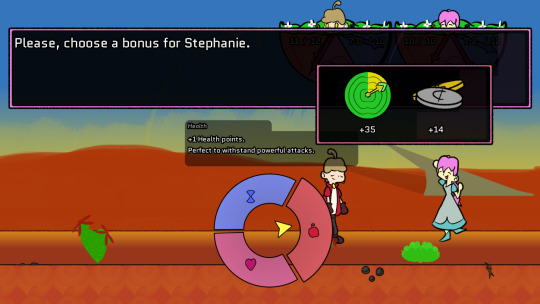
The first one was easy: every level up you get MP (Memento points) and can choose whether to upgrade Health, Love or Time, which are just base stats. Not only does this make the choice less clear-cut as to which one is better, I can make the game a bit harder since players will always get stronger stat-wise AND equipment-wise.
The second one is much more complex. For this, I took inspiration from many sources. Bug Fables, Paper Mario Dark Star, The Binding of Isaac, Friggin’ shonen anime and more. So I will explain the design philosophy I have figured out.
There are two types of mementos: what I call “General” and “Core”.
General mementos are ones that do a very simple thing that’s always kinda nice: Heals some Health every couple of turns, increases defense a bit, gives a new skill, increases Time gained each turn, etc.
Core mementos, on the other hand, are ones that basically require you to base your strategy around them or they will not provide much use: Increase attack, but only at low HP; increase defense every even turn, but decreases it every odd turn; gives more moves per turn, but only if your partner has fallen; etc. These are very strong, come in groups (The “Danger” mementos, the “inter” Mementos, the “Lonely” mementos) to really encourage you to use them, but they come with a drawback, a condition, a risk.
You might even think this distinction is “obvious”, but I invite you to go though Paper Mario’s badge list and consider which ones could be considered “core” (and which of those are actually good). I don’t see many, personally. That’s something that Bug Fables and Paper Mods get: they give you more “core” strategies to play around, like status effect builds, “do nothing” strats and such. It also help that they are harder (specially the mods) so strategy is often mandatory.
Something else I think is crucial: make the mementos synergize. Don’t just make a “Danger” strat, and a “Lonely” strat. Make it so you can try and do a “Lonely-Danger” strat too!
A Memento that requires you to have Low Time to activate? Now if only there was a Memento that increased your attack by making it cost Time... A memento that increases your defense every other turn? If only there was a memento that increased your defense when you used the “Wait” command so that you could negate the stat drop...
Of course, not every memento or strat goes well with every other one, but by designing a series of mementos this way I hope to give not only a lot of choices, but make them easy enough to start with so the player gets wacky with it.
Maybe at some other point I will show more individual mementos, but I think this post is already very long.

Oh, yeah. The little pick-up quote when you pick up any item? That comes from Isaac. I think it adds that little touch of personality (and maybe lore???) to each memento without having to flood the item description.
And why are they called mementos? First one is because I wanted a name that started with M, so it was similar to Medals. The second reason is plot related! If you want to find out, you can play the game here!
3 notes
·
View notes
Text
What would be a platform game without platforms
Outside of battle mechanics, the game has an “overworld”, AKA everything that isn’t a battle. I thought a lot about it, looking into many genres: maybe a top down RPG, maybe a 3D platformer. But finally, decided that the less resource heavy option was a 2D platformer since that way I could reuse battle and overworld assets. I also don’t know how to 3D model, so that aided the choice.

But there are many types of platformers, so how should I design it? I asked myself out loud. I knew it had to have aiming, because that’s the game’s main mechanic. And with that I thought of 2 extremes: Making the most intense action packed platformer where you go guns blazing everywhere, or a slower, puzzle-focused platformer. I decided for the second option.
Why? Not only was it easier to develop, but I thought the first would be bad for the game, actually. I envision it like this: Imagine any action platformer game you like. Imagine that, every time you stomp on an enemy, a turn-based battle starts. It would kinda suck and would stop the pace no matter how quick the battle system was, wouldn’t it? You’d want to completely avoid battles, in an RPG. That’s not good.
That’s why the overworld movement is slow and sorta sluggish. That’s why the jump has a windup. That way, enemies aren’t always easy to avoid without thinking a path first, encouraging you to not dodge them and instead battle ‘em. Of course, I want the game feel good to play, I don’t wanna neuter the controls, just limit the player movement so that the overworld has a slower, calmer pace.
Still, I did have some fun with it. For the first builds, while you could aim in midair, you couldn’t shoot, as that would kind break a lot of puzzles. But a lot of my friends said that kinda sucked, so I made it so shooting in midair gave you a small boost!

Another thing my friends found was... a bug with slopes which made you go way too fast. I’m just gonna show to you what they recorded.

So I fixed it, but I added a way to still trigger something similar to it because it was pretty fun, even if its practical uses are limited.

There are other “advanced” movement techniques, but I think these two are enough for now. If you want to sluggishly jump your way to victory, you can find the game here.
2 notes
·
View notes
Text
How 2 talk to people (even if you’re really shy)
The last of the main game mechanics, yipee!
Only being able to KO and beat enemies always felt incomplete on my previous game. Plus, I saw some people even saying they felt bad beating up some of the enemies because they were too cute!
And, as I’ve mentioned in previous posts, if the battle layouts got very funky you could just become unable to hit an enemy and get softlocked. So there has to be a way to deal with enemies no matter where they are on the field.
This game is about Apples and Love, but also Time. Those are three things, so it’d make sense they each had a corresponding stat.
So I knew I had to add a pacifist option, that used a stat different to the Magic/Mana/PP stat and, to prevent softlocks, that stat had to replenish over time. And that’s the basic mechanics of talking, really.

The mechanic went through a lot of thought until I landed on something similar to Persona 1/2′s demon negotiation, but much less complicated. You use an ability from the ones you know, you do a little minigame sometimes, and that ability has some effect on foes! Each foe has a different susceptibility to different abilities, so for example, an enemy might be “weak” to music-based skills, but not minding the “Encourage” skill. Some foes are also weak to being gifted specific kind of items, or being hit with specific attacks in specific parts (like feeding someone an apple).
This also had some really cool side effects on other aspects of the games’ design:
Since using skills required time that replenished every turn, it was much more important to have survivability than raw power, making defensive strats much more useful if you go this route!
Making it so skills have the ability to convince foes encourages the player to use those skills on non-boss encounters instead of not bothering with them.
By making it a mechanic, people are more likely to remember enemies since they now must have a personality!
Of course, as this is the first go of this mechanics, it ain’t perfect.
The first problem is that players might gravitate to only one beating, KOing or talking to foes, and not try and mix and match them. To solve this, the game is simply designed to kinda force you to. The first boss is designed to be nigh impossible if you don’t mix and match them (or strategize), and some foes are just very hard to KO/kill/talk o you are encouraged to beat different foes differently. Besides the design, KOing or defeating foes just gives you some extra Time, so if you don’t have enough for a skill you can just try and do something else!
The second one is on enemy design. As there is a limited number of skills there is a limited amount of enemy variety so that the enemies’ personalities don’t feel too samey. This isn’t a problem in the game (I hope), it just made me have to start getting creative for some of the later designed foes. If I ever give this another go, though, I’ll find a way to differentiate enemies more. Maybe some foes could adore music and others hate it, and you could convince enemies by either being nice or annoying to them. But that’s a future problem.
I’m probably just overthinking stuff and the mechanic’s probably fine. But if I don’t overthink it, who will?
2 notes
·
View notes
Text
A mimir
Continuing with another not very well explained title, I’m going to ramble on about another game mechanic.
You can aim your attacks, but what is there to aim to? Enemies are pretty big, so aiming at them is not much of a challenge. But what if you needed to hit them at specific points?
And that’s where the basic idea for Knocking out enemies came from!

Actually, that’s not true. The basic idea came from an RPG campaign with my friends. I was the DM and the setting was a robot apocalypse so, because they were robots, I showed that they had to turn hit their off button to recharge and stuff like that. But then, my friends, instead of beating them, dodging them or trying to talk to them, started to turn the robots off themselves! It was really cool!
So when coming up with this battle system, the idea of knocking enemies out when hitting their weak point came naturally. If you hit their weakpoint they get KO’d, which makes all attacks deal more damage. And if every enemy is KO’d, you win! Though, they will get back up eventually.
But, I found another problem: If there are two party members on the field, then you could only KO two enemies at a time, so the KO win condition would almost never happen. To solve this, I took inspiration from the Persona/Shin Megami Tensei franchise, so when you KO an enemy you also get an extra turn!
Now thanks to the extra turn, Knocking Out is the best way to deal with foes, but I’m okay with that since it’s more fun tan simply attacking them and, specially later on, will require thought and resource management. It’s almost like a puzzle!
To aid in that, I gave Stephanie a skill. Time Stop! Which is just the paralysis or petrified status from any RPG. That way, with the extra turn you get from a KO, you can stop ‘em from getting up, which could allow for some extra damage (like through bosses), or to make KO everyone easier the following turn.
If you want to KO everything you find, you can do so here.
#Indiegame#paperverse#SMT#persona#tabletop rpgs are so fun who would've known doing stuff with friends was nice
2 notes
·
View notes
Text
Why do apples fall?
The game I’m making is like an RPG n’ stuff. So like, how do you fight. How do you play the videogame??
One step at a time, here are the basic battle mechanics.


The base concept of the battle system is aiming your attacks instead of choosing a target!
The idea came from when I was making a quirky earthbound-inspired RPG about bread (surprisingly not the only one that exists) and instead of figuring out a system on choosing who to attack I was lazy and just let you place down attacks with a set movement so you had to choose where to put them for maximum effect.

That game sucked and was wholly unbalanced, but you live and learn.
Later, in another game, I experimented on that idea and came up with a combination of it and Paper Mario, so instead of aiming wherever, you had to take into consideration the position of your characters too, kinda like a strategy game. But for this style of gameplay, I had to come up with a new style for attacks.
The first one was obvious: If you want to shoot at an enemy just shoot at them, with a bullet, that goes in the most predictable pattern of all time: a line.
However, this attack presents a weakness: if an enemy is behind another it cannot hit it! So that’s where the idea of lobbing attacks comes from. And like the simple one was a bullet, this lobbing attack would be a bomb attack.

That game's not that good, but it’s getting there!
And so, for this game, I wanted to improve all the things that held it down from being great.
And one of the things I actually thought where pretty good is those basic attacks! They were really simple and easy to get, but allowed for a lot of hidden depth!
Specially the bombs. I really liked how those came out. Because lobbing attacks have a limited range, there are moments where you would just barely miss your target, but with the extra range of the explosion you'd just barely hit your target! So that’s why apples fall and explode, not only a wink and a nudge to the almost-definitely-fake story that Isaac Newton discovered gravity by watching an apple fall, but also because of game design.
But the fact that lobbing attacks have a range showed the main problem with that battle system. Specially in later battles, it was very possible to get softlocked as you would never be able to hit far away foes and, sometimes, they wouldn’t be able to hit you. That wasn’t very fun.
So I made a lot of tweaks. The first one is that now all attacks deal a minimum 1 damage to enemies, so incredibly defensive enemies wouldn’t suck so much to fight.
The second is giving Thomas - the one with the exploding apples - a new ability: Wind Up, that allows him to get enough range to basically hit the entire screen from basically anywhere. And instead of using PP (Aka Magic Points like in any RPG), it uses Time, which replenishes every turn making it so you’re never truly stuck.

The last change is the introduction of another way to “defeat” enemies, which I’ll go more in depth in the future as I think this post is already way too long.
So that’s all for the basic attacks for the main characters! I hope this was an enjoyable read! If you want to shoot apple bombs, you sure can here.
#indiegame#gamedev#paperverse#in this game you wont be able to shoot a bullet through kirbys head sorry
2 notes
·
View notes
Text
This seems like a fun thing to start
I’m making an RPG videogame. Yipee-doo!


And I wanna talk about it, because I wanna share with the world my thoughts while making it, so why not give this a try, seems fun and something I’ll definitely not get bored of in a month.
I just want to talk about it. I don’t wanna make videos trying to justify every decision trying to make it more grandiose than it really is. I don’t wanna have to type out a funny interaction to try and get traction and fail to an algorithm that will never give me a light of day. I don’t want to use Twitter. I just want to talk about my stuff and point out the little things I find neat on them and feel proud. Maybe there'll be a heart out there that vibes with my same excitement over the minutia that clocks have hands and eyes have apples. And if the person that gets excited by the idea of trivia is you, I’m glad this message found you.
If all this blabbering about interested you and want to play the game, you sure can. It’s free and I hope to keep it that way because opinions on art, copyright and more that maybe one day I’ll be motivated enough to share.
This game is quite a bit done, so hopefully I have enough stuff to talk about for a while. I don’t even know what I’ll talk about next, but if you’re reading this far, I hope you find out with me.
Thank you!
4 notes
·
View notes

